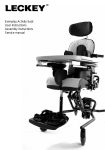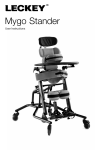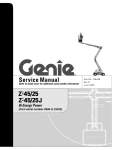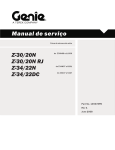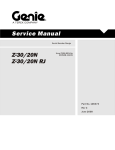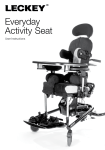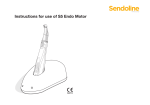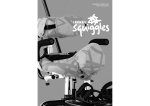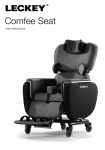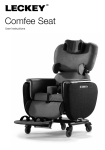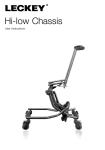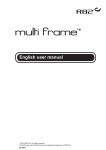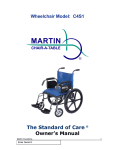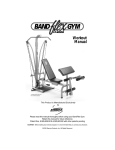Download User Instruction (4MB PDF)
Transcript
Mygo Max User Instructions The Mygo Max has been designed to offer a high level of postural positioning while enabling function and mobility. This manual shows how you can quickly, easily and safely make use of all of the functions. The instructions on safety and maintenance will ensure that you will enjoy the use of the product for a long time. Contents 01 Intended Use 02 Declaration of Conformity 03 Terms of Warranty 04 Product History Record 05 Product Training 06 Safety Information 07 How to Unpack and Assemble 08 Fitting the Covers 09 Clinical Setup for Postural Management 10 Frequent Adjustments for Daily Use 11 Cleaning and Care Information 12 Daily Product Inspections 13 Annual Product Inspections 14 Reissuing Leckey Products 15 Product Servicing 16 Technical Information 17Accessories 6 Safety Information 1. Intended Use The Mygo Max is an activity chair which has been designed for children and young adults with disabilities for use at home or in the school environment. It is suitable for clients aged 12 -18 years. The seating system has a maximum user weight of 85kg. The seating system is modular and can be used with a choice of indoor or outdoor chassis. The Hi-low chassis has been designed for use indoors but can also be used outdoors on a level surface. The Hi-low chassis should never be exposed to the elements as this may corrode the metal components. 5. Product Training Record (Parents, Teachers & Carers) Your Leckey product is a prescribed Class 1 Medical Device and as such Leckey recommend that parents, teachers and carers using the equipment should be made aware of the following sections of this user manual by a technically competent person: 2. Declaration of Conformity James Leckey Design Ltd as manufacturer with sole responsibility declares that the Mygo Max conforms to the requirements of the 93/42/EEC Guidelines, Medical Device Regulations 2002 and EN12182 Technical aids for disabled persons and test methods. Section 12 Cleaning and Care 3. Terms of Warranty The warranty applies only when the product is used according to the specified conditions and for the intended purposes, following all manufacturers’ recommendations (also see general terms of sales, delivery and payment). A two year warranty is provided on all Leckey manufactured products and components. 4. Product History Record Your Leckey product is classified as a Class 1 Medical device and as such should only be prescribed, set up or reissued for use by a technically competent person who has been trained in the use of this product. Leckey recommend that a written record is maintained to provide details of all setups, reissue inspections and annual inspections of this product. Section 6 Safety Information Section 11 Frequent Adjustments for Daily use Section 13 Daily Product Inspection Leckey recommend that a written record is maintained of all those who have been trained in the correct use of this product. 6.1 Always read instructions fully before 6.8 When the seat is in use on a Hi-low chassis please ensure that the height use. adjustment pedal and tilt in space lever are locked off and cannot be adjusted accidentally by other children. 6.2 To improve safety we recommend that users should not be left unattended at any time whilst using Leckey 6.9 When the Leckey seating systems equipment. are used on the Hi-low chassis we do not recommend that users are moved over uneven surfaces when in the equipment. 6.3 Only use Leckey approved All due care and attention should be components with your product. Never taken if transporting in and out of the modify the product in any way. Failure to follow instructions may put the user seat. or carer at risk and will invalidate the warranty on the product. 6.10 Never leave the product on a sloping surface, greater than 5 degrees. 6.4 If in any doubt to the continued safe Always remember to lock all the castors. use of your Leckey product or if any parts should fail, please cease using 6.11 Only use the push handle to steer the product and contact our customer and move the seat from one area to services department or your local another. Never use the tray for this dealer as soon as possible. purpose. 6.5 Carry out all positional adjustments and ensure that they are securely fastened before you put the user into the product. Some adjustments may require the use of a tool which is provided with each product. Keep all tools out of reach of children. 6.6 When putting the user into a seating system, both for positional and safety reasons, always secure the Leeway Pelvic Cradle first. 6.7 When the product is stationary ensure that all castors are locked and facing away from the base, as this will improve product stability. This is especially important when the tilt in space or back recline facility is in use. 6.12 The product contains components which could present a choking hazard to small children. Always check that locking knobs and bolts within the child’s reach are tightened and secure at all times. 6.13 Leckey products comply with fire saftey regulations in accordance with EN12182. However the product contains plastic components and therefore should be kept away from all direct sources of heat including naked flames, cigarettes and gas heaters. 6.14 Do not place objects hotter than 40oC on the tray.t is in use on a Hi-low chassis please ensure that the height adjustment pedal and tilt in space lever are locked off and cannot be adjusted accidentally by other children. 6.15 Clean the product regularly. Do not use abrasive cleaners. Carry out maintenence checks on a regular basis to ensure your product is in good working condition. 6.16 The product is designed for indoor use and when not in use should be stored in a dry place that is not subjected to extremes of temperature. The safe operating temperature range of the product is +5 to +40 deg Celsius. 6.17 Always check the plastic hand knobs on the push handle are tightened securely before you move the seat unit. 6.18 Before using the seating system always check that the interface handle on the seat unit is fully engaged with the chassis. If the handle is not engaged properly the seat unit may come loose and could cause serious injury to the child or carer. How to unpack and assemble the seating system 7 Check parts Congratulations on purchasing your Mygo Max System. All of the parts will be contained in polythene bags with each one clearly labelled. Carefully remove them from the boxes and check all the parts you have ordered. Keep polythene bags away from children. Some of the accessories will need to be assembled before you attach the seat to the base you have purchased. Multi-tool A number of adjustments will require the use of the multi-tool, which is supplied with each seat and can be found in the back pocket of the seat. 7.1 Setting the footrests 7.2 Attaching the seating system to the Hi-low chassis Open up the angle of the leg supports by unscrewing the knobs (A), shown, and set to the maximum width. Open the socket caps (B) and slide in the calf supports. Set to the desired position, with the footplates facing forward and retighten the socket cap bolts with the multi-tool. Adjust the height of the chassis to its maximum to reduce risk of back strain while attaching the seat unit. Refer to Section 11 on how to adjust the height of the chassis you have purchased. Always make sure the foot plate is attached firmly. A B First release the safety locking pin at the front of the seat. To do this pull the pin out and rotate through 90 degrees. Carefully lift the seat and place it into the chassis. At the rear of the underside of the seat you will see a receiving channel. Place this securely over the tube towards the back of the chassis. Pull the handle at the front of the seat unit up and then pivot the seat forward and down. Once the front of the seat is lowered fully, release the handle and push it forward to ensure it has fully engaged on the front tube. Rotate the safety locking pin so it engages in front of the handle. If it hits the handle then the seat is not inserted properly. Remove and repeat process outlined above. Always check the handle and locking pin are fully engaged before you place the child in the seating system. If the handle is not engaged properly the seat unit can come loose and could cause serious injury to the child or carer. 7.3 Attaching the push handle 7.4 Attaching the headrest 7.5 Attaching the lateral supports The push handle is attached to the seatbase by inserting the two lower stems into the receiving tubes as shown. Secure the handle in place by tightening the locking knobs (a). To attach the head support slide the stem into the receiving bracket. Set to the desired position and secure using the hand lever (a). While holding the components together, remove the screw and washer. Align the plastic angle adjuster mouldings and lateral bracket with the slot in the backrest and refit the washer and plastic screw. Check these regularly to make sure the knobs are tight, particularly if you are moving the product unit along corridors that may have uneven or sloping surfaces. A 7.6 Attaching the Leeway Pelvic Cradle 7.7 Attaching the sandals 7.8 Attaching the armrests 7.9 Attaching the Tray Fasten the front buckle and side.Velcro tabs of the Leeway Pelvic Cradle. Attach the four side release buckles (a), two at the back of the seatbase and two at the side. If sandals are required they can be attached to the footplates with a single fixing bolt. To position the sandals simply loosen the knob (a) under the footplate, select the position you require and re-fasten the knob. Slide the armrest into the receiving bracket. Adjust to the required height and retighten the knob. The tray is attached to the seat by inserting the tray tubes through the centre of each armrest. Once the tray is located in the position the knob (a) should be tightened securely. A A A 7.10 Attaching the Hip Laterals 7.11 Attaching the ankle huggers 7.12 Attaching the protraction pads To attach the hip laterals to the sacral support, loosen screw (a) and insert the bar of the hip lateral into the hole on the side of the sacral support. Tighten the screw to secure. Slide the webbing through the slot in the sandal. Loop the webbing back up and through the bottom of the triglide. Then pass the webbing through the top of the triglide. Finally to lock the webbing in place, pass it through the bottom of the triglide again. Trim strap to required length. To attach the protraction pads, remove screw (a) from metal bracket on the standard lateral. Place the protraction pad on top of the bracket and replace with the new longer screws which are included. Retighten using the allen key. Attach to the seat as per 7.5. 1 A 3 2 4 A Fitting the cushions 8 8.1 Femoral cushions 8.2 Seat base cushion Slide a femoral cushion onto each of the femoral supports and secure them by pressing down on the poppers on either side. The seat base cushion can be attached by simply setting it in place and securing the two popper tabs (a) at the back of the seat base. To secure further hook the elastic tabs to the hooks (b) underneath the seat base. Always check the seat base cushion is secure before placing the child in the seat. A B 8.3 Backrest Cushion 8.4 Leeway Pelvic Cradle 8.5 Sacral Cushion 8.6 Hip Laterals First of all loosen the shoulder support laterals with the allen key provided. Slide the cushion over the laterals and secure using the two snap fasteners. Slide the flaps over the top of the backrest and underneath the bottom of the backrest and secure with the snap fasteners. Fasten the Leeway Pelvic Cradle and place on the seat base cushion. Press Velcro onto the seat base cushion and attach four straps (a) to secure. There are two camlocks at the back of the seat and one on either side. Fit the sacral cushion over the hardware and fasten at the back with the snap fasteners. The standard sacral support should be attached with the double flaps at the top. Slide the cushion covers over the hip lateral with the open zip on the outside. Close the zip and secure the Velcro flap. 8.7 Trunk Harness 8.8 Lateral Supports 8.9 Chest Harness 8.10 Headrest cushion Slide each of the four straps (b) through each of the camlock brackets and secure by pushing down on the camlocks. Then connect the shoulder straps (c) into the two camlocks at the top and two at the side. Slide the cushion covers over the lateral support with the open zip on the outside. Feed the plastic buckle through the slot in the cover, close the zip and secure the Velcro flap. The chest harness can be attached by clipping the male buckle (a) into the female buckle (b) at either side of the lateral supports. Place the cushion onto the head support. Snap the central fastener and two side fasteners in place. Bring the lower flap under the head support and attach the Velcro. B A C B 8.11 Padded Tray Insert Slide the tray into the padded tray insert and secure the six snap fasteners. Two at the top, two at the bottom and two at the sides. Clinical Setup for Postural Management 9 9.1 Leeway Pelvic Cradle 9.2 Hip Lateral The Leeway Pelvic Cradle should be flat and open when the user is placed into the Mygo Max. All four side and starps should be already attached to the seat. First fasten the buckle (a) at the front of the Leeway Pelvic Cradle. Then fasten the Velcro (b) at the sides to fit the Leeway Pelvic Cradle to the user. Then adjust the front and rear straps (c) and (d) to secure to position the user’s pelvis. The hip laterals can be width and angle adjusted to suit the user’s requirements. Loosen the screws (a) at the back of the sacral support. Move the hip laterals to required position. Ideally the hip laterals should always be rotated so they rest on top of the seat cushion even if the backrest or sacral support is angled. Once the hip laterals are in position, retighten the screws securely. The laterals can also be angled to help support, abduction adduction or windsweeping. To adjust the angle of the hip laterals loosen the screw (b) on the hinge of the hip lateral. Adjust to the required angle and retighten the screw. The pads can also be adjusted in depth and a small degree of rotation by loosening the screws (c) on the pad, sliding it to the required position and retighten the screws. A C B C A D B 9.3 Backrest Height 9.4 Backrest Angle 9.5 Adjusting the upper leg supports 9.6 Adjusting the femoral guides To adjust the overall height of the backrest loosen the two screws in the middle of the backrest, adjust to the required position and retighten securely. The height can be fine tuned with the user in the seat. To change the angle loosen the screw at the bottom of the backrest spine, adjust to the required position and retighten the screw securely. The upper leg supports will be set at the minimum position on arrival. Set the depth before placing the child in the seat. Fine adjustment is possible afterwards but is restricted by the user’s weight. To achieve the correct position measure the length from the child’s lower back to the back of their knee. To adjust the width of the femoral guides. Loosen the screws (a) and position as required. Retighten the screws. There are two screws per femoral guide. Use caution when adjusting to minimum setting as fingers could become trapped between moving and static parts. The backrest angle can be adjusted with the user in the seat. The backrest spine has a useful angle indicator designed to indicate the preferred position or back angle for different activities. Hold the backrest spine with one hand while you adjust the back angle. Adjust the supports to the desired position using the two knobs underneath the seat base. To adjust, loosen the knobs, slide to the desired position and retighten. Keep the supports pointing straight forward at this time unless wind sweeping or adduction, abduction must be accommodated, in which case set the angle accordingly using the knobs again. A 9.7 Footsupport Height 9.8 Calf Support 9.9 Foot Support Angle 9.10 Sandals To raise or lower the height of the footsupport, loosen screw (a) adjust to the required position and retighten the screw securely. The foot support has a useful height indicator designed to indicate the preferred position, To adjust the calf support angle, loosen the screw (b) at the top of the calf support, move front or back to the required angle, then retighten the screw. To set the angle to accommodate plantarflexion or dorsiflexion, simply loosen or tighten the screw (a) to select the angle you require. To position the sandals simply loosen the knob (a) under the footplate, select the position you require and re-fasten the knob. To position the user’s feet in the sandals secure the Velcro ankle and toe straps provided. The foot supports can simply flip up to aid transfer. B A A A 9.11 Adjusting the Sacral Support 9.12 Lateral Supports Standard Sacral Support To adjust the height, depth or angle of the standard sacral support, loosen the two screws (a) on either side of the bracket, move to the required position and retighten the screws. Standard laterals Loosen the bolts (a) to adjust the width, height and angle of the lateral supports and retighten when you have achieved the desired position. Ball & Socket Sacral Support To adjust the height or depth of the ball & socket sacral support, loosen each screw (a) on either side of the bracket, move to the required position and retighten the screws. To adjust the angle, loosen both the screws (b) on the ball and socket joint. Position the support at the required angle and retighten the screws. Flipaway laterals Adjust width, height and angle as above. The laterals can be flipaway by pulling pin (b). The complex laterals can also be angled to allow the pad to contour to the user’s shape. To adjust loosen the bolt (a) at the centre of the pad, angle the pad to the required position and retighten the bolt. The laterals can be flipaway by pulling pin as per the flipaway laterals. The lateral supports have a useful height indicator. Complex laterals The complex laterals can be used in whatever combination is most suited to the user’s requirements. To adjust the height width and angle of these laterals, loosen bolt (a) and retighten when you have achieved the desired position. A A A A B B 9.13 Chest Harness 9.14 Trunk Harness 9.15 Shoulder Support 9.16 Head support To change the width of the chest harness, lift the front cover, adjust the Velcro straps to the desired width and replace the cover. The trunk harness will be open but remain attached by the clip (a). When placing the child in the seating system bring the trunk harness across the front and attach by connecting the clip into the buckles on the other side (b). All of the connecting straps are adjustable by releasing the camlock, adjusting to the desired position and then securing the camlock. To adjust the angle of the shoulder support laterals, loosen screw, move laterals to required angle and retighten. To adjust the height, depth and angle of the contoured headrest, loosen the hand knobs (A) and when set to the desired position retighten the knobs. Do not remove the headrest while the user is in the seat. Never use the headrest to force the position of the user’s head. Always use caution to ensure fingers do not become trapped when adjusting the headrest A B A 9.17 Armrest adjustment 9.18 Tray Adjustment To adjust the height of the armrest loosen the hand knob (b), set to the desired height and retighten. To adjust the angle, rotate ratchet handle (a) until the desired position has been achieved. The height and angle of the tray are set by adjusting the armrests as detailed above. To remove or adjust the depth of the tray loosen the knobs (a) under the armrest, set to the desired position and re-tighten securely. Always use caution as fingers could become trapped in the slot when adjusting the height. Always use caution to ensure the child’s hands or arms do not become trapped when inserting the tray. Never use the tray to steer or push the chair. Do not place objects, hotter than 40 degrees Celsius on the tray. Please note that the tray is for the use of the user only. Do not lean or place objects on the tray, greater than 8kgs (17.6lbs). B A A Frequent adjustment for daily use (therapists/ carers/parents) Parents and carers should be shown how to make frequent adjustments and be made aware of the safety checks in Section 6 by a technically and clinically competent person who has been trained in the use of the product. Leckey recommend that a written record is maintained of all parent and carers who have been trained in the use of this product. 10 10.3 Chassis 10.1 Transferring your child into and out of the seat 10.2 Adjusting the Leeway Pelvic Cradle Before transferring the child into the seat carry out the daily product inspection as outlined in section 13 of this user manual. Adjust the seat to a comfortable height to facilitate transfer. Lock all the castors, ensuring that they are facing outwards to maximise product stability. Make sure the safety buckle on the chest harness is released and is out of the way to facilitate transfer. The correct positioning and tensioning of the Leeway Pelvic Cradle is key to a child’s postural management, affecting their comfort and ability to carry out activities. Please consult with your therapist to ensure the Leeway Pelvic Cradle is positioned correctly and that the straps are tensioned appropriately. To tension the Leeway Pelvic Cradle use the 4 side straps (c) and the velcro tabs (d). If using the seat outdoors and your child is wearing a coat, position the Leeway Pelvic Cradle under the coat. To prepare the Hi-low chassis for the seating system we recommend that you raise the chassis to a comfortable working height by pressing the foot lever at the rear of the chassis or by pressing the up button on the handset of the powered option. If the seat has flip-away thoracic laterals, first move these out of the way using knob a. Unclip the Leeway Pelvic Cradle in the middle, undo the side velcro of the Leeway Pelvic Cradle and allow the harness to open out to facilitate transfer. Lastly if sandals are fitted open the straps. You are now ready to transfer or hoist the child into the seat. The Leeway Pelvic Cradle is fastened using the middle buckle, and side velcro. Always secure the Leeway Pelvic Cradle first before fastening other buckles or harnesses. Adjust the harness so the child cannot slide or creep forward in the seat. C C The Mygo Max is designed to fit onto a range of chassis. This user manual shows the correct and safe use of the seating system with the Leckey Hi-low chassis. For all other chassis or bases please refer to the manufacturer’s handbook. D 10.4 Powered height adjustment 10.5 Charging the battery The powered chassis can be easily adjusted with the push button control handset. The seat can be height adjusted with the client in the chair. When one of the buttons on the handset is pressed, then the seat will move up or down in that direction until the button is released again, or if the actuator has reached the end of its stroke.The system is started by inserting the battery into the circular holder in the end of the control box. Clean the magnetic poles for all dirt or metal chips before inserting. The battery will magnetically hold itself in place with the correct position , and a confirming long beep is heard. The control box checks the battery level every 24 seconds, and when the battery reaches a low limit, then the control box will give a double-beep every 24 seconds to indicate that the battery needs recharging. This is done in the ”C3-charger”, full re-charging takes 5-8 hours, depending on state of charge. To remove the battery, turn it 90 degrees (right- or left) to release it from the magnets . The battery (NiMH-type) can be recharged from any state of charge without reducing battery life or batterycapacity. When connecting the ”C3-charger” to the mains (100 – 240 V AC), the red diode lights up continuously and a single flash in the green diode appear before it turns off again. When inserting the battery into the charger, the green diode starts flashing with an interval of 1/sec during the charging process. When charging is finishing, the green diode stops flashing and turns on continuously, the battery is fully charged, can be removed and is ready for use in the C3 controller. 10.6 Height Adjustment – Hi-low Chassis Repeated runs at a high rate with heavy loads, may create overheating inside the battery – a safety interlock-temperature sensor will disconnect the power. When the battery has cooled down to accepted working temperature the power switch on automatically. To secure long lifetime of NiMH batteries, it is recommended to recharge the battery at least every 3 months. Beep signals: Long beep: Power on (battery inserted) Two short beeps: Every 24 seconds (when the system is not in use): = indicating low battery level, please recharge. Two short beeps: When starting the actuator = low voltage, please change battery soon, or recharge—the battery will still give power, but only limited time. Long beep: When running the actuator = battery lower than 17,6Volt (only down/in movement will be accepted thereafter) Continuous short beeps: (Temperature inside control box too high, please take a break) You can carry out this adjustment with the child in the chair. To adjust the height of the Hi-low chassis press the foot lever at the rear of the chassis or press the up button on the handset of the powered option whilst holding the push handle. Once you remove your foot from the pedal or your thumb from the handset the seat will be fixed at the chosen height. For safety the height adjustment pedal on the chassis can be locked by engaging the pull pin (C) on the right hand side of the pedal. To unlock pull the pin out and rotate 90 degrees, the pedal can then be operated. The locking pin (C) should be kept in the locked position when you are not adjusting the chassis. Always keep the locking pin engaged when you are not adjusting the chassis. This will prevent the foot pedal being operated accidentally. Always use caution as hands could become trapped when height adjusting the base. 10.7 Tilt in space 10.8 Chest and Trunk Harness Adjustment The tilt in space can be angled while the user is in the seat. Before you adjust the tilt in space angle of the seat always ensure the pelvic harness is secured preventing the user from sliding forward in the seat. If the child requires chest support as part of their postural support programme the seat will be fitted with rigid laterals or a combination of laterals, chest harness and trunk harness. These may need to be adjusted on a daily basis to accommodate differences in clothing. Please refer to section 9.14 for specific guidance on adjusting the trunk harness. Always check with your therapist as to the optimum positioning and tensioning of the straps and support items for the child. Check the harness and laterals are secure to ensure the child is safe and cannot slide forward in the seat as this may restrict their breathing. To adjust the tilt angle pull the lever on the push handle. Once you have selected the angle you require, by simply removing your hand from the handle, the chair will be locked in position. Please use handle bars when operating tilt in space. Always check with your therapist that the use of tilt in space will not cause any obstructions A A To change the width of the chest harness, lift the front cover, adjust the Velcro straps and set to the desired width. When the correct width has been achieved replace the cover. Always make sure the plastic buckles are fully engaged when using the chest harness. 10.9 Sandals 10.10 Tray Adjustment 10.11 Armrest adjustment To position the user’s feet in the sandals secure the Velcro straps provided so the foot is held in place. The straps should be placed over the bridge of the foot and over the toes. The activity tray can be used for a range of functions and its position can be fine tuned to suit the user and the activity whether it is for fun, education or feeding. The tray is attached to the seat by inserting the tray tubes through the centre of each armrest. Once the tray is located in the position the knob (a) should be tightened securely. Adjust the armrests to set the height and angle of the tray. To adjust the height of the armrest loosen the hand knob (b) set to the desired height and retighten. To adjust the angle rotate hand knob (a) until the desired position has been achieved. If the child is wearing sandals or light footwear check the straps to make sure the webbing does not irritate the skin. To remove the armrest completely for side transfer or assist in getting the child into or out of the seat loosen hand knob (c), and remove knob. Always use caution as fingers could become trapped in the slot when adjusting the height. Always use caution to ensure the child’s hands or arms do not become trapped when inserting the tray. Never use the tray to steer or push the chair. Do not place hot objects, greater than 40 degrees Celsius on the tray. Please note that the tray is for the use of the user only. Do not lean or place heavy objects on the tray, not greater than 8kgs (17.6lbs). A C B A 11 Cleaning & Care How to Maintain When cleaning we recommend that you use only warm water and a non-abrasive detergent. Never use organic solvents or dry cleaning fluids. Upholstery and fabrics 1. The cushion covers can be removed, machine washed at 40ºC and tumble dried at a low temperature. All other soft upholstery can be placed into the washing machine intact, after removing bolts and fastenings. 2. The upholstery and fabrics can also be cleaned by hand whilst in place. When cleaning we recommend that you use only warm water and a non-abrasive detergent. 3. Staining should be removed as quickly as possible with absorbent cloth, towels or a sponge. Routine soap and warm water sponging is effective for ordinary soiling and minor spills. Be careful not to over wet the fabric as this will cause the stainingto spread. 4. Antiseptic cleaning agents can be used on more stubborn stains. These may require a safe solvent such as Isopropyl Alcohol or Mineral Spirit. A half cup of household bleach to 5 litres of water can also be used as a useful disinfectant. 5. The Leeway Pelvic Cradle and trunk harnesses can be machine washed at 40 Deg C. Make sure all bolts and fasteners are removed first as they may cause damage to your washing machine. Store these in a safe place and out of reach from children. 6. Always ensure the product is dry before use. 12 Daily Product Inspection Metal and plastic components 1. Soap and water or antibacterial spray can be used for daily cleaning. 2. For deep cleaning a low pressure steam cleaner can be used. 3. Do not use solvents to clean plastic or metal components. 4. Make sure the product is dry before use. (Therapists, parents & carers) We recommend that daily visual checks of the equipment are carried out by therapists, carers or parents to ensure the product is safe for use. The recommended daily checks are detailed below. 1. C heck that there is no lateral movement or wobble in any of the moving parts. Ensure all adjustment knobs and bolts are in place and secure. 2. C heck all upholstery and Velcro for signs of wear and tear. 3. C heck all castors are moving freely and lock securely. 4. E nsure the handle and locking pin on the seat interface plate is fully engaged and the seat unit is securely fixed onto the chassis. 5. E nsure the Leeway Pelvic Cradle is fully secured around the user and they cannot slide or creep forward in the seat. 6. Ensure the footplate is attached securely. If in any doubt to the continued safe use of your Leckey product or if any parts should fail, please cease using the product and contact our customer service department or your local dealer as soon as possible. 13 Annual Product Inspection 14 Re-issuing Leckey Products (Therapist, Technician, Leckey Product Advisor, Dealer) Leckey recommend that each product should be subject to a detailed inspection at least once a year and every time the product is reissued for use. This inspection should be carried out by a technically competent person who has been trained in the use of the product and should include the following checks as a minimum requirement. 6. Lift the base to check each castor individually. Make sure they are moving freely and remove any dirt from the rubber wheels. Check that the brakes lock the wheels securely 1.Check that there is no lateral movement or wobble in any of the moving parts. Ensure all adjustment knobs and bolts are in place and secure. 8.Leckey recommend that a written record is maintained of all annual product inspections. 2.Check all ratchet handles, knobs, nuts, bolts and plastic buckles are in place, replacing any missing items. Paying particular attention to the following items; > Headsupport locking bolts. > Backrest height and angle adjustments bolts. > Seat depth adjustment bolts. > Leeway Pelvic Cradle / hip guide attachment bolts. > Footrest height and angle adjustment. 3.Check the chassis height adjustment mechanism is working properly. If the chassis is foot pedal operated ensure the seat height doesn’t change when the pedal is released. Also, check that the locking pin engages securely to prevent accidental height adjustment of the chassis. 4.Adjust the seat to its maximum range of tilt in space and ensure that the locking lever locks the seat out securely at varying point in this range. 5.Check that where the seat and chassis join there is no visible wear and tear on the metal components. 7.Visually check the structure of the product paying attention to weld points on the frame ensuring there are no signs of fatigue or cracking around the welds. If in any doubt to the continued safe use of your Leckey product or if any parts should fail, please cease using the product and contact our customer service department or your local dealer as soon as possible. Most Leckey products are assessed and ordered to meet the needs of an individual user. Before reissuing a product we recommend that the therapist prescribing the product has carried out an equipment compatibility check for the new user and has ensured that the product being re-issued contains no modifications or special attachments. A detailed technical inspection should be carried out on the product prior to re-issuing. This should be carried out by a technically competent person who has been trained in the use and inspection of the product. Please refer to section 11 for the required checks to be carried out. Ensure the product has been cleaned thoroughly in accordance with section 12 of this manual. Ensure a copy of the user manual is supplied with the product. A copy can be downloaded from our website www.leckey.com Leckey recommend that a written record is maintained of all product inspections carried out during the reissue of the product. If in any doubt to the continued safe use of your Leckey product or if any parts should fail, please cease using the product and contact our customer service department or your local dealer as soon as possible. 15 Technical Information Product and 161-600 161-900-02 161-900-03 161-900-04 161-900-15 Accessory Codes Mygo Max Seat Shell Seat Cushion Pack - Orange Seat Cushion Pack - Blue Seat Cushion Pack - Pink Seat Cushion Pack - Grey Chassis 161-693 161-679 Hydraulic Hi-Low Base Powered Hi-Low base Accessories 161-688Armrests 152-3600Sandals 161-610 Lower Leg Supports 161-689 Flipaway lateral supports 161-690 Complex lateral supports 161-691 Protraction pads with lateral supports 161-692 Angle adjustable sacral pad 161-608 Large femorals 161-967 Padded tray cover 161-961 Memory foam cushion pack 161-695Tray 147-2600 Leeway Pelvic Cradle Size 2 147-2610 Leeway Pelvic Cradle Size 3 155-LEC-002 Fitting kit for Harness 155-N001-L Large Trunk Harness 161-696 Side Pads Mygo seat dimensions Size Size 3 Age 12 - 18 Max User Weight 85 Seat Depth Min 410mm / 16.4 inches Max 560mm / 22.4 inches Seat Width Min 345mm / 13.8 inches Max 500mm / 120 inches Chest Width Min 170mm / 6.7 inches Max 270mm / 10.6 inches Back Height Min 330mm / 13.2 inches Max 510mm / 20.4 inches Seat to Sandal Min 330mm / 13.2 inches Max 510mm / 20.4 inches Plantarflexion / Dorsiflexion 10° to 10° Back Angle +10° to -25° Windsweeping up to 20° Calf Angle -15° to +30° Tilt in Space +10° to -25° Armrest Min 360mm / 14.2 inches Max 700mm / 27.5 inches Actuator specification- 500055+493312020000 Rated IP66 Duty Cycle Max 10% or 2 min continuous use followed by 18 min not in use. Operation temperature -5degC to +70degC, storage temperature -40degC to +70degC. Push/pull Max 4500N Self Lock at 4500N Push/Pull Typical speed with full load 6,0mm/sec Max amps at load of 4500N is 8 amps Power input voltage 24v +- 10% Battery Box – C3BAT Rated IP51 Type: NiMH Power supply: 24V DC Maximum continuous current: 7A (short time peak current 10-20A) Capacity: 1400mAh Low-capacity warning: Sound signal Handset – C3REMOX incl. foil Rated IP51 Control Ambient temp +5deg to +40deg C Battery Charger – C3CHAR Power supply: 110-240V AC Charging time: 5-8 hours Mains connector: European/UK/US type Battery change: Easy revolving fastening Charging signal: Green light flashing Full capacity signal: Continous green light Products may be stored in non-heated storage facilities with humidity between 0 and 100%, none condensing. None condensing means that one should not take a product from an ice cold warehouse into a room with a temperature of 20deg C; if this is done then moistness will appear on the products. Leckey 19 Ballinderry Road Lisburn BT28 2SA Northern Ireland United Kingdom T: 028 9260 0750 F: 028 9260 0799 E:[email protected] W:www.leckey.com Stephen 24 hour postural care for babies, kids & adults. Sleeping, Sitting, Standing, Walking, Moving, Bathing, Toileting. LS314-01



























